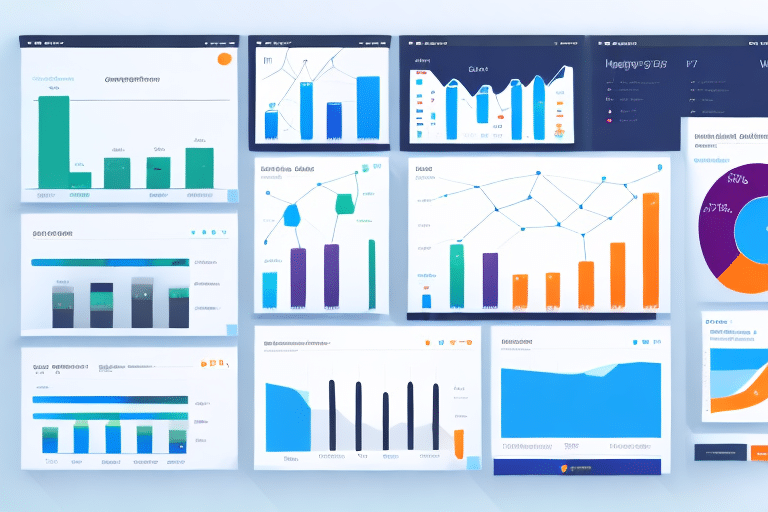Understanding Conversion Rates and Their Importance
Before diving into the strategies for improving your conversion rate, it's essential to understand why conversion rates are critical for your business's success. Your conversion rate is the percentage of website visitors who complete a desired action, such as making a purchase, filling out a form, or subscribing to a newsletter. A high conversion rate directly correlates with increased sales and profits, while a low conversion rate indicates missed opportunities and potential revenue loss.
Moreover, conversion rates offer valuable insights into the effectiveness of your marketing campaigns, website design, and overall user experience. By consistently tracking and analyzing your conversion rates, you can identify strengths and weaknesses in your strategies, allowing you to make informed, data-driven decisions to optimize your website and drive more sales. According to a WordStream study, businesses that focus on conversion rate optimization can see a significant boost in their overall profitability.
Analyzing and Tracking Conversion Metrics
Understanding your starting point is crucial before implementing any optimization strategies. Begin by tracking a variety of metrics to gain comprehensive insights into your conversion performance:
- Conversion Rate by Traffic Source: Determine which channels (e.g., organic search, paid ads, social media) are driving the most valuable traffic and which may need more attention.
- Conversion Rate by Device: Analyze how mobile and desktop users behave differently to identify and address potential issues specific to each device type.
- Bounce Rate: A high bounce rate signifies that visitors are leaving your site without engaging, possibly due to irrelevant content or poor user experience.
- Time on Site: Short visit durations may indicate that your content or design isn't resonating with visitors, suggesting the need for improvements.
- Click-Through Rate (CTR): Assess the effectiveness of your calls-to-action (CTAs) by measuring how often they are clicked compared to how often they are viewed.
Regularly monitoring these metrics provides a clear picture of your current performance and highlights areas that require optimization. Utilizing tools like Google Analytics can assist in tracking these vital statistics accurately.
Identifying Factors Influencing Conversion Rates
Several factors can influence your conversion rate. Identifying and addressing these can lead to substantial improvements:
- Website Design/Layout: A cluttered or confusing website can hinder navigation, making it difficult for visitors to find what they need and complete desired actions.
- Page Load Speed: Slow-loading pages frustrate users, increasing the likelihood of them abandoning your site. According to Google, even a one-second delay can reduce conversions by up to 7%.
- CTA Placement: Strategically placing CTAs where they are easily visible and accessible can significantly boost their effectiveness.
- Copywriting: Engaging and persuasive copy tailored to your target audience can enhance user engagement and drive conversions.
- Trust and Credibility Factors: Building trust through social proof, such as customer reviews and endorsements, can increase visitor confidence and conversion likelihood.
By pinpointing these factors, you can develop targeted strategies to overcome specific challenges and enhance your website’s performance.
Strategies for Optimizing Conversion Rates
Optimizing Website Design and Layout
- Simplify Your Navigation: Streamline your site's navigation to help visitors easily find what they're looking for, reducing frustration and drop-offs.
- Use White Space: Effective use of white space makes your site visually appealing and less overwhelming, improving readability and focus.
- Make Your CTAs Stand Out: Utilize contrasting colors and larger fonts to ensure your CTAs catch the visitor's attention and prompt action.
- Use High-Quality Images: Incorporate high-resolution images to enhance visual appeal and engage visitors better.
- Test Your Design: Conduct A/B testing to determine which design elements perform best and optimize accordingly.
Implementing these design strategies can significantly improve your website's user experience, leading to higher conversion rates. Studies have shown that a well-designed website can increase customer trust by up to 58% (Smashing Magazine).
Crafting Irresistible Calls-to-Action (CTAs)
- Use Action-Oriented Language: Incorporate strong action verbs like "Download," "Register," or "Get Started" to make your CTAs more compelling.
- Be Specific: Clearly state what visitors will receive by clicking your CTA, providing clarity and setting correct expectations.
- Create Urgency: Phrases like "Limited Time Offer" or "Only a Few Spots Left" can create a sense of urgency, encouraging immediate action.
- Keep It Simple: Ensure your CTAs are clear and concise, avoiding unnecessary words that may dilute the message.
- Test Your CTAs: Experiment with different languages, colors, and placements to identify which combinations yield the highest conversions.
Effective CTAs can lead to a significant increase in conversion rates. For instance, a well-designed CTA can improve conversion rates by up to 113% (WordStream).
Leveraging Social Proof
- Showcase Customer Reviews: Displaying positive customer reviews prominently on your site can enhance trust and credibility.
- Highlight Social Media Followers: Showcasing your social media following numbers can build credibility and signal popularity.
- Include Customer Logos: Featuring logos of well-known companies you’ve worked with can boost your site’s credibility.
- Display Awards and Recognitions: Highlighting any awards or recognitions your business has received can further establish trust with visitors.
According to B2B Marketing studies, including social proof can increase conversions by up to 34%.
Enhancing User Experience to Boost Conversions
A user-friendly website is essential for improving your conversion rate. Implement the following tips to enhance user experience:
- Optimize for Mobile: With over 60% of web traffic coming from mobile devices (Statista), ensuring your site is mobile-friendly is crucial.
- Include Search Functionality: Adding a search bar helps visitors quickly find what they're looking for, reducing frustration and increasing the likelihood of conversion.
- Minimize Form Fields: Request only essential information to avoid overwhelming visitors, thereby reducing form abandonment rates.
- Make It Easy to Contact You: Providing clear contact information, such as phone numbers, email addresses, and live chat options, builds trust and facilitates conversions.
Enhancing user experience not only improves conversion rates but also fosters customer loyalty and repeat business.
Implementing Strategic Marketing Techniques
Email Marketing
Email marketing remains one of the most effective channels for nurturing leads and driving conversions. Enhance your email marketing efforts with these strategies:
- Segment Your Email List: Divide your email subscribers into segments based on demographics, behavior, or interests to deliver personalized and relevant content.
- Optimize Your Subject Lines: Craft compelling and catchy subject lines to increase open rates and engage your audience from the outset.
- Include a Clear CTA: Ensure each email contains a prominent call-to-action that directs recipients toward the desired action.
- Send Follow-Up Emails: Reach out to leads who have shown interest but have not yet converted, keeping your brand top-of-mind and encouraging eventual conversion.
According to DataPost, segmented email campaigns can result in a 760% increase in revenue.
Leveraging Video Marketing
Video marketing is a dynamic tool for engaging visitors and driving conversions. Utilize the following tips to harness the power of video:
- Use Video on Your Landing Pages: Embedding videos can increase engagement and provide a richer understanding of your offerings.
- Keep Your Videos Short and Engaging: Aim for videos between 30 seconds and two minutes to maintain viewer interest and effectively convey your message.
- Include a CTA: End your videos with a clear call-to-action to guide viewers toward the next step.
- Use Video in Your Email Marketing: Incorporating videos in emails can boost engagement and click-through rates.
Research by Wyzowl indicates that video marketers achieve a 49% faster revenue growth rate than non-video marketers.
Implementing Retargeting Strategies
Retargeting is an effective strategy to re-engage visitors who have previously interacted with your site but haven't converted. Implement these retargeting strategies:
- Use Pixel Tracking: Install a tracking pixel on your site to monitor visitor behavior and display targeted ads across various platforms.
- Create Compelling Ad Campaigns: Develop ads with clear messaging, appealing visuals, and persuasive CTAs to entice visitors to return and complete their actions.
- Create Targeted Landing Pages: Design specific landing pages for retargeted visitors that emphasize your value proposition and streamline the conversion process.
According to WordStream, retargeting can lead to a 150% increase in website conversion rates compared to standard display ads.
Personalizing Your Approach
Personalization can significantly enhance customer engagement and boost conversions. Implement the following personalization strategies:
- Use Behavioral Targeting: Analyze visitor behavior data to tailor messaging, offers, and CTAs to specific audience segments.
- Address Visitors by Name: Personalize communications by addressing visitors by their first name to create a more personalized experience.
- Include Personalized Recommendations: Utilize data on previous purchases or browsing history to provide tailored product recommendations, increasing the likelihood of conversion.
Studies by Segment show that personalized experiences can deliver five to eight times the ROI on marketing spend and lift sales by 10% or more.
Continuous Testing and Measurement for Conversion Improvement
Continuous testing and measurement are vital for the ongoing improvement of your website's performance. Implement the following strategies:
- Conduct A/B Tests: Test different versions of design elements, CTAs, and messaging to determine which variations yield the best results.
- Track and Analyze Metrics: Regularly monitor key metrics like conversion rates, traffic sources, and user behavior to identify trends and areas for improvement.
- Use Heatmaps and Data Visualizations: Tools like Hotjar provide heatmaps that show where users are clicking and how they're interacting with your site, offering insights into user behavior.
Implementing a robust testing and measurement framework allows you to make informed, data-driven decisions that enhance conversion rates over time.
Effective Lead Generation and Nurturing Strategies
Effective lead generation is vital for building a robust customer base and increasing conversions. Consider the following strategies:
- Offer Valuable Content: Create high-quality content such as whitepapers, eBooks, or infographics that visitors can download in exchange for their contact information.
- Create Targeted Campaigns: Develop campaigns focusing on specific audience segments, delivering tailored messaging and offers that resonate with their needs.
- Use Opt-In Forms: Implement opt-in forms on your website to capture contact information from interested visitors, facilitating future engagement.
- Follow Up Promptly: Respond quickly to leads who have expressed interest in your business to maintain engagement and build trust.
According to HubSpot, companies that excel at lead nurturing generate 50% more sales-ready leads at 33% lower cost.
Conclusion
Improving your conversion rate is a continuous process that demands regular monitoring, testing, and optimization. By understanding the factors that influence your conversion rate and implementing targeted strategies to address them, you can enhance your website's performance, maximize profits, and cultivate a loyal customer base. Embrace these best practices and leverage data-driven insights to achieve sustained growth and success in your online business endeavors.




















